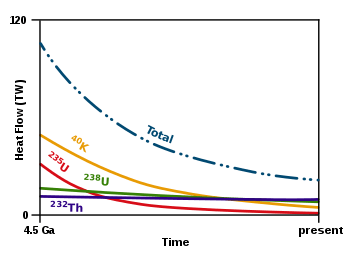Potassium-40
| Potassium-40 | |
|---|---|
| General | |
| Name, symbol | Potassium-40,40K |
| Neutrons | 21 |
| Protons | 19 |
| Nuclide data | |
| Natural abundance | 0.0117(1)% |
| Half-life | 1.251(3)×109 y |
| Isotope mass | 39.96399848(21) u |
| Spin | 4− |
| Excess energy | −33505 keV |
| Binding energy | 341523 keV |
Potassium-40 (40K) is a radioactive isotope of potassium which has a very long half-life of 1.251×109 years. It makes up 0.012% (120 ppm) of the total amount of potassium found in nature.
Potassium-40 is a rare example of an isotope that undergoes all three types of beta decay. About 89.28% of the time, it decays to calcium-40 (40Ca) with emission of a beta particle (β−, an electron) with a maximum energy of 1.33 MeV and an antineutrino. About 10.72% of the time it decays to argon-40 (40Ar) by electron capture, with the emission of a 1.460 MeV gamma ray[1] and a neutrino. The radioactive decay of this particular isotope explains the large abundance of argon (nearly 1%) in the earth's atmosphere. Very rarely (0.001% of the time) it will decay to 40Ar by emitting a positron (β+) and a neutrino.[2]
Potassium–argon dating

Potassium-40 is especially important in potassium–argon (K–Ar) dating. Argon is a gas that does not ordinarily combine with other elements. So, when a mineral forms – whether from molten rock, or from substances dissolved in water – it will be initially argon-free, even if there is some argon in the liquid. However, if the mineral contains any potassium, then decay of the 40K isotope present will create fresh argon-40 that will remain locked up in the mineral. Since the rate at which this conversion occurs is known, it is possible to determine the elapsed time since the mineral formed by measuring the ratio of 40K and 40Ar atoms contained in it.
The argon found in Earth's atmosphere is 99.6% 40Ar; whereas the argon in the Sun – and presumably in the primordial material that condensed into the planets – is mostly 36Ar, with less than 15% of 38Ar. It follows that most of the terrestrial argon derives from potassium-40 that decayed into argon-40, which eventually escaped to the atmosphere.
Contribution to natural radioactivity

The radioactive decay of 40K in the Earth's mantle ranks third, after 232Th and 238U, as the source of radiogenic heat. The core also likely contains radiogenic sources, although how much is uncertain. It has been proposed that significant core radioactivity (1-2 TW) may be caused by high levels of U, Th, and K.[3]
40K is the largest source of natural radioactivity in animals including humans. A 70 kg human body contains about 160 grams of potassium, hence about 0.000117 × 160 = 0.0187 grams of 40K; whose decay produces about 4,900 disintegrations per second (becquerels) continuously throughout the life of the body.[4][5]
See also
Notes and references
- ↑ This photon would be called an x-ray if emitted from an electron. In nuclear physics, it is common to name photons according to their origin rather than their energy, high energy photons produced by electrical transitions are called "x-rays" while those emitted from atomic nuclei are called "gamma rays" irrespective of their energy.
- ↑ Engelkemeir, D. W.; Flynn, K. F.; Glendenin, L. E. (1962). "Positron Emission in the Decay of K40". Physical Review. 126 (5): 1818. Bibcode:1962PhRv..126.1818E. doi:10.1103/PhysRev.126.1818.
- ↑ Wohlers, A.; Wood, B. J. (2015). "A Mercury-like component of early Earth yields uranium in the core and high mantle 142Nd". Nature. 520 (7547): 337–340. Bibcode:2015Natur.520..337W. doi:10.1038/nature14350.
- ↑ The number of radioactive decays per second in a given mass of 40K is the number of atoms in that mass, divided by the average lifetime of a 40K atom in seconds. The number of atoms in one gram of 40K is Avogadro's number 6.022×1023 (the number of atoms per mole) divided by the atomic weight of potassium-40 (39.96 grams per mole), which is about 0.1507×1023 per gram. As in any exponential decay, the average lifetime is the half-life divided by the natural logarithm of 2, or about 56.82×1015 seconds.
- ↑ Bin Samat, S.; Green, S.; Beddoe, A. H. (1997). "The 40K activity of one gram of potassium". Physics in Medicine and Biology. 42 (2): 407. Bibcode:1997PMB....42..407S. doi:10.1088/0031-9155/42/2/012.
External links
- Potassium-40 Section, Radiological and Chemical Fact Sheets to Support Health Risk Analyses for Contaminated Areas
| Lighter: potassium-39 |
Potassium-40 is an isotope of potassium |
Heavier: potassium-41 |
| Decay product of: — |
Decay chain of potassium-40 |
Decays to: argon-40, calcium-40, Stable |